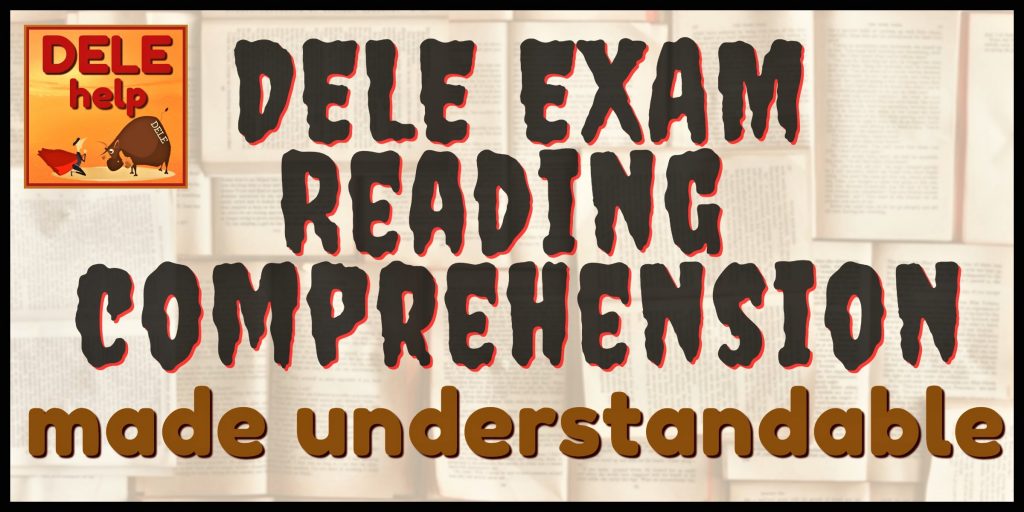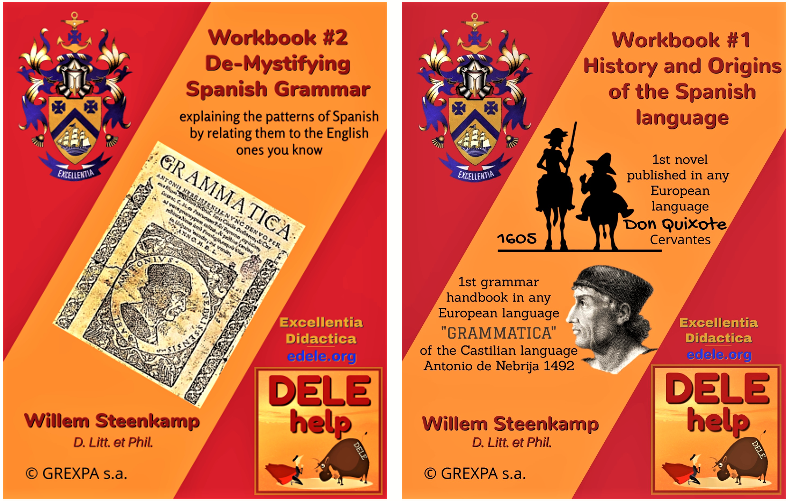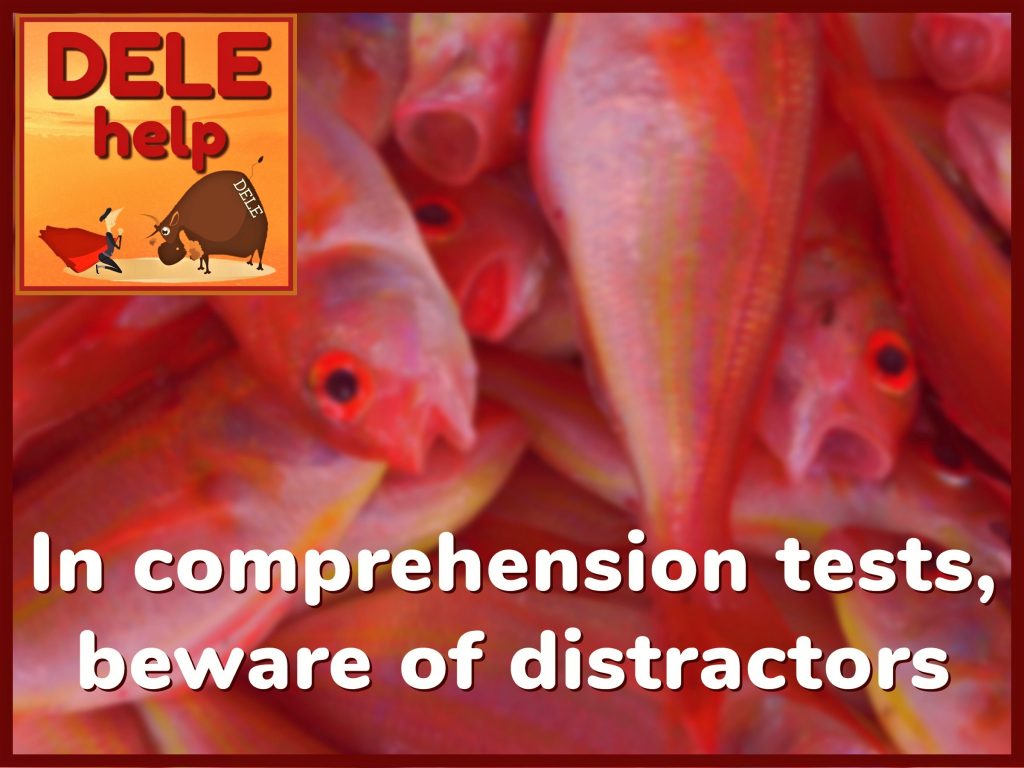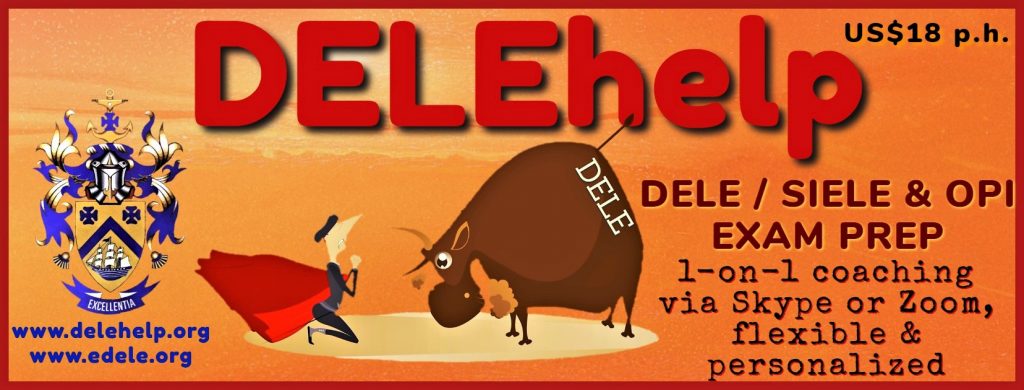TOP TIPS FOR ACING SPANISH READING COMPREHENSION TESTS

Acing Spanish Reading Comprehension Exams – our top tips
Acing Spanish reading comprehension tests, such as for the DELE / SIELE / RPT exams, can appear daunting – but it need not be, if you understand the techniques that examiners use, and the importance of having a sufficiently ample lexis of Spanish vocabulary and expressions). In this blog post we will share with you our battle-tested tips for acing these tests.
“Reading Comprehension Requires Knowledge—of Words and the World”
Note: since the DELE / SIELE use the same curriculum and assessment criteria developed i.t.o. the Common European Framework of Reference for Languages – the CEFR – which the American RPT Reading Proficiency Test (from the OPIc Oral Proficiency Interview stable) also use, in this post we will refer only to the DELE by name, for the sake of brevity and convenience; references to the DELE thus wills subsume the SIELE and RPT as well, unless otherwise indicated. 
One can prepare for reading comprehension exams:
It is no secret that the part of the DELE exam that students fear most, is the first half of it that tests one’s comprehension of what you read and what you hear. This is done by means of “monkey puzzles” or more properly called multiple choice question papers. We will deal today with reading comprehension. The tips we will give you, apply also to the equivalent segment of the SIELE exam (the new online twin of the DELE) which is the SIELE S2 (unlike the DELE, where all four communicative competencies are tested in one exam sitting on one day, the S2 can be taken any time, as a free-standing test). The same applies to the American equivalent RPT, or Reading Proficiency Test. It must be understood that the principles and format are largely the same for all three reading comprehension tests, whether DELE, SIELE S2 or RPT.
One of the reasons why the DELE exam reading comprehension test is so feared, is the somewhat misplaced belief that one cannot really prepare for these exams. While it is true that one cannot specifically prepare (because the examiners’ universe of topics from which to select for the exam questions is just too vast and random), one can indeed generically prepare for acing Spanish reading comprehension tests.
To many students, the topics of the multiple-choice questions they encounter in the DELE exam reading comprehension seem not to have been covered in the typical DELE exam preparation programmes on offer, with the latter’s strong grammar / verb conjugation focus. It is as if there’s no identifiable nexus between the topics encountered in the reading and listening comprehension, and the content of the group classes many students have taken. Meeting up with such a calamity, of course, most often results when the student (or more correctly, a tutor fixated with a school-style teaching approach) hadn’t looked up the actual DELE curriculum before planning their examen DELE preparation.
Get familiar with the Curriculum:
The official DELE diploma curriculum inventory document in fact does contain pertinent guidance for preparing oneself for the comprehension parts of the exam. To paraphrase the introductory quote above, from Prof. Eric D. Hirsch jr.: you need to sharpen and broaden your knowledge of Spanish words, and of the Hispanic world. It is here where such elements of the curriculum as one’s linguistic repertoire (especially vocabulary) and the curriculum’s chapters on “Cultural Reference Framework”, “Knowledge of, and Customs of Socio-Cultural Conduct”, and “Intercultural Dexterity” come into play.
An excellent tool for orientating yourself regarding the examen DELE and its goals, format, curriculum, scoring criteria, plus our top tips for acing the DELE exam, is our one-of-a-kind DELE / SIELE exam preparation book called “DELE / SIELE Exam Orientation and Acing Tips“. You can obtain this 96-page book FREE and without any obligation, by simply asking for it, using our convenient contact information form (just click on the image below).
The Key to Acing Spanish Reading Comprehension tests is ample LEXIS – Know the words:
The first debacle that a candidate needs to avoid in reading comprehension tests, is encountering words or expressions in the exam text that the candidate simply doesn’t recognize. Not knowing what the meaning is of key words or expressions, can cause one to entirely misunderstand a given text. Obviously, the only solution to this challenge, is to work hard to develop as extensive a vocabulary as possible. The importance of lexis (words as well as expressions / idioms) cannot be overstressed. MAKE FLASHCARDS and learn them (they should preferably be digital, using free resources such as www.cram.com or ANKI, or they can be old style, on cardboard). Keep in mind that all Spanish nouns have gender, so please learn the noun together with its gender.
For Acing Spanish Reading Comprehension – Know the context:
The other important exam-day blank to avoid, is not being able to situate the given piece of text in its socio-cultural context. In other words, not being able to relate it to some kind of reference framework derived from general knowledge of the Hispanic world, which context will help explain what the text is all about. As Prof. Hirsch points out: “The only useful way to prepare for a reading test is indirectly – by becoming a good reader of a broad range of texts, an ability that requires broad general knowledge”.
To illustrate the importance of situational meaning as determined by context, with an example taken from English: the word “pot” can mean something that you grow flowers in, or use for cooking, or that your gran had under her bed, or even that some people smoke.
A top tip is to diligently read the Spanish print media. Papers like El País and El Mundo all have free digital versions; remember to read not only the front page actualities, but also the specialized sections on culture, education, science and the like – many DELE / SIELE exam texts are lifted from these two papers. To optimize the value of your reading efforts, you need to diligently look up the meaning of all new words you encountered, and add them to your flash-card system.
Our blog post with LINKS to top DELE exam prep RESOURCES
Acing Spanish Reading Comprehension tests requires fluency in reading:
Being able to quickly read and grasp meaning is an important skill to cultivate, in addition to acquiring knowledge of words and of the Hispanic world. It relates to how fast and discerningly you are able to actually read the text in front of you (remember, each exam task is subject to quite stringent time constraints).
The more time you spend on deciphering individual words letter by letter, the less time you have remaining to you for focusing on the main task of forming an understanding of the content. In addition to time being consumed, it is also a question of mental energy and capacity being consumed if you struggle to read. If you consider that it is alleged that working memory can hold only seven items at the best of times (i.e., those times when your mind is free to focus on content) the importance of not being hamstrung by reading difficulties is self-evident.
You may already be aware that, the more fluently we read, the more we read entire words as pictograms, rather than reading individual letters and assembling these into words. We therefore become skilled at reading like the Orientals do, with their whole-word pictograms. To illustrate this phenomenon, see how relatively easily you can recognize these familiar English words, even with their letter order all jumbled up: Mkae Amricae gorw; insevt loaclly.
Attaining reading fluency permits one to concentrate on comprehending the content, rather than being side-tracked by struggles with forming words from what seems to be unfamiliar jumbles of letters and having to pause to try and recall what those words each signify. Recognizing words instantly, and knowing their meaning without conscious effort at recall, allows the candidate to save time and mental energy, so as to be focused on context and message content. Such fluency in reading comes only from practice, practice, practice and from an ample lexis of vocabulary, collocations and expressions.
Our DELEhelp Workbooks on vocabulary and on Spanish idioms and expressions are important additional free tools for acing Spanish reading comprehension, which you will receive when you sign up with us. The vocabulary workbook, for example, explains the rules (or patterns) governing transforming cognates from English to Spanish. Since some 38% of words in English and Spanish stem from similar roots, knowing these patterns will help significantly in recognizing words you may not have directly learnt in Spanish, but with the meaning of which you are actually quite familiar. But beware – there are a few “false cognates” as well! (like embarazo meaning pregnancy, and not embarrassed).

The role of grammar in Acing Spanish Reading Comprehension tests:
Your knowledge of Spanish grammar can provide important contextual clues to help you select the correct answer from the multiple-choice options offered.
It must be kept in mind that, unlike English vocabulary, Spanish nouns have gender and Spanish verbs are conjugated. When reading exam texts, merely recognizing the root form of a word will often not suffice. One must know enough grammar to be able to identify in which mood and tense the verb is presented in the text (to comprehend its true nuanced meaning) and must also know the gender of nouns – for example, in order to be able to select between two synonyms being offered as multiple-choice solutions.
To illustrate the point about gender, look at this example (taken from a B-2 mock exam). Two possible options presented in a multiple-choice paper of the type where the student needs to fill in a missing word in the exam text, were the synonyms “desastre” and “debacle”. In terms of meaning, both could have worked in this particular instance. However, only “debacle” was correct, because the text read: “Primero hay que sobrevivir a la ___ de encontrar un nuevo piso”. If you didn’t know that “desastre” is masculine and therefore takes “el” but “debacle” is feminine and therefore goes correctly with the “la” in the text, you would have been stumped.
Or take this grammar example, also from a B-2 mock exam: “…aunque sea obsequiando con una gran sonrisa ___ entrar al ascensor.” The options given were: “cuando”, “mientras” and “al”. Only a knowledge of grammar would enable the student to know with certainty that it needs to be “al” – because the verb directly following on the blank space (i.e., “entrar”) is in the infinitive, and grammar rules that, following “cuando” as well “mientras”, verbs need to be conjugated and not stated in the infinitive; of the three options, only “al” can be followed by an infinitive.
Once we have mastered vocabulary (and, in Spanish, the related gender/grammar), broad domain knowledge helps us to make sense of word combinations. It has been said that “reading requires the reader to make inferences that depend on prior knowledge – not on de-contextualized ‘inferencing’ skills.” In plain English: one cannot look at words in isolation; their meaning often depends on their context in relation to accompanying word patterns, which have acquired fixed meaning (such as collocations and idiomatic expressions). It is also true that we cannot comprehend irony, metaphor and other such literary devices without cultural background knowledge.

Understand the examiners’ technique in setting the DELE exam reading comprehension questions:
For acing Spanish reading comprehension tests, it is also important to understand what the examiners are trying to test in a reading comprehension exam, and how they typically do it (i.e., what is the main technique used in comprehension testing, to separate the proverbial sheep and goats?). In essence, examiners want to be able to differentiate between students with true understanding of the meaning of the message contained in the text, and those who are trying simply to spot apparent similarities. Reading comprehension is NOT a test of your short-term memory retention, NOR of your powers of observation. It tests your understanding of meaning. The examiners want to differentiate between the student who looks at the text and the given options, and then knows with certainty that: “eureka – THAT one reflects the true meaning and is therefore the exact correct option” as opposed to: “hmmm – that one seems to ring a bell, it sort of seems similar”.
So, what technique will examiners use? They will deliberately construct “ring a bell” options (aptly called, in academic parlance, “distractors” or “foils”), incorporating into them words that you would remember having seen in the text. This way they can check whether you merely observed apparent similarities, or truly comprehended meaning. Beware, therefore, when you see purely descriptive elements repeated in the options – these most often are not the correct answer. What examiners often do, in order to check comprehension, is to re-state the correct answer using new words with similar meaning, and see if you understand that the two apparently different phrases (the one in the text and the one in the option) actually mean the same thing.
To give you an example, framed in English – in the text may appear the phrase: “Yesterday the children played in the garden”. You are then given three options: (a) Yesterday the children played in the kitchen (b) Yesterday the children would have loved to have played in the garden; and (c) Yesterday the children played outside. Of these three, (a) appears most obviously wrong. Option (b) is a classic distractor, in that it seems to tick all the right boxes i.t.o. words that appeared in the text such as “yesterday”, “children”, “played” & “garden”. However, if you properly understand the meaning of the phrase, then you would know that this option actually says that the children DID NOT play in the garden, so it is clearly as wrong as (a). Option (c) is the correct answer, because it shows the examiner that you understand the similar meaning of “outside” and “garden”.

Watch out for examiners using distractors (“red herrings”)
What to do inside the exam centre:
Once inside the exam centre, with the text in front of you, there are important steps that should be followed in order to help you comprehend the content of the given texts and to select the right option(s) from the multiple choices offered.
- Keep a check on time;
- Read the given text once for holistic overview of its context, without getting too hung-up on problems encountered – find the main idea and the author’s purpose;
- Read the QUESTIONS / OPTIONS as carefully (if not more so) as you read the text;
- Read the text again, now with the questions in mind;
- Take each question in turn, first eliminating from each set of given choices, those options that are clearly wrong;
- To select among remaining options that appear equally possible, check the grammar, number and gender of words, to see that they correctly fit the text immediately preceding and following the blank space;
- Keep in mind that this is not a test of your powers of observation or short-term memory, but of your understanding of meaning – therefore, watch out for the seeming repetition of words from the original text in the answer options, because the correct answer will more than likely not be that, but rather a synonym or some such different word of similar meaning to the original, to test that you understand, instead of merely having observed and recalled;
- From your study of the curriculum, you will know that the examen DELE places a lot of emphasis on fluency of communication, which depends a lot on correct use of link phrases – so, be prepared for your knowledge of these (and of their appropriate use) to be tested, especially at B-level and above;
- When you are confronted with a task requiring you to insert whole phrases in a text, be especially careful, because the number of options given normally match exactly the number of blank spaces (usually six or so). This means that if you have one wrong, you of necessity will have another one wrong as well, since you have “used up” the (in)correct answer and therefore will not be able to place it in its correct space – thus a double jeopardy. In these types of tasks, it is important to look at punctuation: look to match option phrases that have their first word commencing with a capital letter, to spaces where the preceding phrase terminated in a full stop. Similarly, where the preceding phrase (before the blank space) had ended on a comma or in a manner not obliging the next phrase to start with a capital, look for option phrases starting with lower case.
If all else fails, look for the shorter option to be correct – remember that the examiners need to construct and embellish options to catch out the “that rings a bell” syndrome, and such options most often require them to use more words in Spanish. (This may be the exact opposite approach to what you’ve been taught for English-language multiple choice exams, where the longer answer is often the correct one; to understand the difference between the languages, keep in mind that Spanish uses precisely conjugated verbs to say exactly what it means).
The Center for Teaching Excellence of the University of Wisconsin at Eau Claire provided these additional tips to their students:
- Responses that use absolute words, such as “always” or “never” are less likely to be correct than ones that use conditional words like “usually” or “probably”.
- “Funny” responses are usually wrong.
- “All of the above” is often a correct response. If you can verify that more than one of the other responses is probably correct, then choose “all of the above.”
- “None of the above” is usually an incorrect response, but this is less reliable than the “all of the above” rule.
- Look for grammatical clues.
- If you cannot answer a question within a minute or less, skip it and plan to come back later. Transfer all responses to the answer sheet at the same time, once you have marked all questions on your exam. (If you try to do several things at once, you increase the probability of making a mistake. Saving the relatively mindless job of filling in bubbles until the last step reduces the probability of making silly errors.)
- If all else fails, choose response (b) or (c). Many instructors subconsciously feel that the correct answer is “hidden” better if it is surrounded by distracters. Response (a) is usually least likely to be the correct one. (Note – we here at DELEhelp did a quick statistical analysis of an entire actual DELE exam set (A1 to C2), checking the correct answers to the multiple-choice questions for reading and for listening comprehension, and we found this borne out: A=74 times, B = 94 times, and C = 84 times. However, be it upon your own head if your failings in particularly your vocabulary preparation, oblige you to use this statistical shot-in-the-dark guessing method!).
The good news is that the DELE diploma’s comprehension exam sections are not marked negatively (i.e., you will not lose marks for wrong answers).
In summation:
The right approach to the comprehension segments of the examen DELE, is to be as fresh and clear of mind as possible on the day of the exam (don’t pull an all-nighter!) Stay calm and methodical, and know that there is indeed a logic to selecting the right answer to every question. To accustom yourself to spotting that logic, the key is practice, practice and again practice – doing as many exam simulations as you can fit in, and then reviewing your results in detail with your tutor, so that you can see where (and why) you had gone wrong.
Above all, though, you have to avoid the sickening feeling of not even being able to progress to logical deduction, because you simply didn’t recognize key words you encountered. For that, there’s no other remedy than constant vocabulary learning, diligent reading practice to improve reading speed and expand relevant domain knowledge, and doing as many mock exams as you can. We recommend the ModeloExamen DELE mock exams available from Bubok publishers as e-books: http://www.bubok.es/buscar/modeloexemen-dele .
To learn more about how our experienced tutors here at DELEhelp may assist you Acing Spanish Reading Comprehension and with your preparation for the DELE / SIELE or RPT / OPI in general please click on the IMAGE BELOW
Buena suerte!
Willem




Hola – una pregunta, please: how do you guide students through the use of the simulated exams?
Hola Sr Bill: Thanks for the question – we do the exam simulations as realistically as possible. The written parts our students normally do in their own time, at home, but following strictly the exam rules. Afterwards they scan their answers and send them in to us for review. The oral expression part of the exam we do during a regular Skype session, but each time using a different tutor with whom the student isn’t familiar as the examiner. These accurate simulations have three goals. The first is purely familiarization, so that the candidate can enter the exam centre without trepidation of the unknown; he or she will really know the format inside out, which naturally raises the confidence level (very important for the oral expression tasks, for example). Secondly, the regular practicing of the different exam components, together with the review and detailed discussion of the candidate’s performance afterwards, definitely do sharpen the analytical abilities of the student when it comes to spotting the right answers in the multiple choice questions, for example. It also ingrains the correct approach when it comes to the planning and execution of the oral and written expression tasks (and allows us to highlight incorrect ones, for correction). This latter aspect ties in with our third goal, which is to diagnose with these mock exams the candidate’s strengths and weaknesses, much as a doctor will order blood and imaging tests of a patient, in order to arrive at the correct prescription. Because our tutoring is strictly one-on-one and not in groups, there’s no fixed, pre-set programme of study that we arre bound by. We draw up (and continuously adapt) a totally individualised programme for each candidate, based on what we learn from these mock exams as diagnostic tools. This allows us to “prescribe” the appropriate remedial action, which could be added focus on certain aspects of grammar, or a need for more ample background knowledge of the Hispanic world, or stronger emphasis on expanding vocabulary. In a nutshell, these mock exams allow us at DELEhelp to know the student’s capacities and needs (and continuously adapt an appropriate personalised programme), whilst allowing the student to know beforehand what to expect on exam day.
Do you offer exam help for c2 people too?
I am Gernan (with a new c2 in English and an old c2 in Spanish).
Dear Inga. Yes, we help DELE candidates (and those for the SIELE and OPI) of all levels. I have sent you a detailed reply from my corporate e-mail account ( [email protected] ) to the query you had sent me from our DELEhelp blog / website. If you do not immediately see my reply (which includes the free Workbook plus the scheduling for your free Skype session) please check your spam filter. Kind regards Willem Steenkamp Director of Studies: DELEhelp